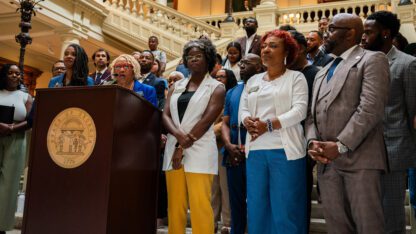Atlanta Coyotes Are Here To Stay, And This Group Is Studying Their Impact

The Atlanta Coyote Project is working with 20 other organizations are joining from cities such as Denver, Los Angeles, Austin, Madison, as well as parts of Canada.
Pixabay
Howling in backyards and posts on neighborhood message board, these have all become signs of Atlanta coyotes. And though they aren’t native to Georgia, the Department of Natural Resources says there is no getting rid of them now.
That’s why one Atlanta professor is working with partners across the country to study the effects of coyotes and urban wildlife in Atlanta.
Professor Chris Mowry, an ecologist with Berry College, kneels next to a spring-fed creek at the bottom of a steep, wooded ravine. He is looking for amphibians along the stream bank. He spots one and shoots his hand into the water, but no luck. This Sandy Springs backyard, with its tall trees and native plants, looks more like North Georgia than the suburbs of Atlanta.
He eventually snags a salamander.
“This is a salamander that is reliant on exchanging gases through its skin. They’re absorbing oxygen through the air and through the water in which they live,” Mowry says. “So they’re very susceptible to pollutants in the environment.”
He says it’s a sign of a healthy ecosystem.
“Wouldn’t surprise me if river otter are using this stream,” says Mowry, as he gestured towards a bank along the creek. “We’ll hope to catch them on our cameras eventually.”
That cameras are the reason he’s in Sandy Springs.
Coyote Cams
Mowry’s focus isn’t primarily on salamanders or otters.
Actually, it’s coyotes.
He’s with the Atlanta Coyote Project, and he’s currently setting up wildlife cameras across metro Atlanta.
The cameras are part of a partnership with the Urban Wildlife Information Network from Chicago. Mowry says soon they will have 40 cameras running all the way from Zoo Atlanta to Milton, Georgia. This will let the Atlanta Coyote Project make comparisons about wildlife across Atlanta but also across North America. Twenty other organizations are joining from cities such as Denver, Los Angeles, Austin, Madison, as well as parts of Canada.
Mowry says this project will help answer questions about coyotes and the animal community.
“What is their role? And what other species are out there?” he says. “And are they influencing those other species in any way?”
Coyotes are a key part of the Georgia ecosystem, according to Mowry. After the red wolf population was wiped out, they moved in and filled the top predator spot.
Though they’ve been in Georgia for decades, many people don’t even know they’re here, says Kaitlin Goode, urban wildlife program manager at the Georgia Department of Natural Resources.
“Coyotes are an extremely adaptable species,” she says. “So they can pretty much live wherever they want.”
That includes the city, which can sometimes be surprising for people. But Goode says just seeing a coyote is not cause for alarm.
“We try to educate people on that as best as we can, that just because you’re seeing a coyote doesn’t mean that there’s an issue,” she says.
But there are things people can do to prevent conflict.
“You definitely want to take steps to make sure that you’re securing your food, and you’re not feeding any other wildlife that could bring the coyote into your yard,” Goode says.
These types of precautions are important because although coyotes aren’t native to Georgia, they are here to stay.
“There’s certainly no getting rid of them permanently now that they’ve been established,” she says.
Run-ins with Atlanta coyotes
Nick Sturm lives in the Atlanta neighborhood of Sylvan Hills and has had several run-ins with coyotes.
“It’s always surprising when it happens. One time I was driving, and I watched it run into the woods,” he says. “The other time I was walking my dogs around the corner of my block, and there’s a coyote just standing in the middle of the road. That time I stopped and turned around.”
But even these sightings don’t concern Sturm. He says he considers the coyotes part of the fabric of his neighborhood.
“Seeing one on the street, or hearing some of them howling at night, adds this weird texture to the neighborhood that reminds you that you live in a city that’s also this flourishing, strange environment,” says Sturm.
And that’s where Mowry, the Atlanta Coyote Project, and the cameras come in.
“I think people are oftentimes surprised and thrilled at what we’re able to show them, what we capture on our cameras. Many people aren’t aware that these animals are out there,” says Mowry. “Urban environments don’t necessarily have to be dead zones for wildlife.”
He plans to capture a month of photos in each season, showcasing the wildlife in Atlanta’s backyard.












